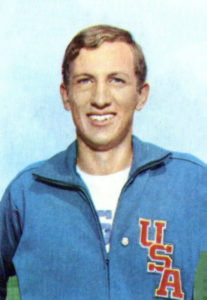Dick Fosbury – Acclaimed Olympic Track And Field Athlete
By PDX People
PORTLAND, OR. – One of the many great things about living in Portland Oregon is the HUGE track and field heritage that we have here thanks to great names like Steve Prefontaine, Ashton Eaton and Dick Fosbury.
About Dick Fosbury
Although Eaton and Prefontaine are two of the most “well-known” track and field names to come from the Portland area, Dick Fosbury is also a top name among the most iconic athletes of the 20th and 20st centuries thanks to his success in track and field and his invention of the “fosbury flop”.
What exactly is the fosbury flop? Although the name sounds like a dance from the 20th century, it was Fosbury’s back first technique which enabled him to excel at the high jump.
His method was to sprint diagonally towards the bar, then curve and leap backwards over the bar, which gave him a much lower center of mass in flight (it was actually below his body) than traditional techniques.
Fosbury, who was born in Portland, Oregon, first started experimenting with a new high jumping technique at age 16, while attending Medford High School.[3] Fosbury had difficulty competing using the dominant high jumping techniques of the period. In his sophomore year, he failed to complete jumps of 5 feet (1.5 m), the qualifying height for many high school track meets.[4] This dominant technique, the straddle method, was a complex motion where an athlete went over the high jump bar facing down, and lifted his legs individually over the bar. Fosbury found it difficult to coordinate all the motions involved in the straddle method, and began to experiment with other ways of doing the high jump.
Fosbury later recalled, “I knew I had to change my body position and that’s what started first the revolution, and over the next two years, the evolution.”[5] At first, he tried to use a technique known as the upright scissors method. In this method, a jumper runs upright towards the bar, facing forward, and during his jump lifts his straight legs one at a time over the bar.[4] High jump rules stipulate only that competitors may only jump off one foot at takeoff: there is no rule governing how a competitor crosses the bar, so long as he or she goes over it.[6]
As he began to experiment with this technique, he gradually adapted it to make himself more comfortable and to get more height out of it. Nonetheless, it was nowhere near as coordinated as a well-performed straddle method jump, and one historian has referred to Fosbury’s early attempts as an ‘airborne seizure‘, but during the latter part of his sophomore year and the beginning of his junior year, it began to produce results, and he gradually was able to clear higher jumps.[4]
Gradually, Fosbury shifted his positioning during the jump, such that by his senior year he had begun to go over the bar backwards, head-first, curving his body over the bar and kicking his legs up in the air at the end of the jump. This required him to land on his back, but prior to his junior year, his high school had replaced its wood chip landing pit with a softer material, so he was able to land safely.[4]
Luckily for Fosbury, replacement of landing surfaces with foam rubber was becoming common across the United States in the early 1960s. Sawdust, sand, or wood chip surfaces had been usable previously because jumpers using the scissors technique were able to clear the bar while upright and then land on their feet, while those using the Western Roll or Straddle made a three-point landing on their hands and lead leg. In the late 1950s, American colleges began to use bundles of soft foam rubber, usually held together by a mesh net. These bundles were not only much softer, but were also elevated about 3 ft (0.91 m) off the ground. By the early 1960s, American high schools were following the lead of the colleges in acquiring foam rubber landing pits. With the new, softer, elevated landing surface, Fosbury was able to land safely.
Fosbury’s coaches at first encouraged him to continue practicing the straddle method, but abandoned that when his marks continued to improve. In his junior year, he broke his high school record with a 6 ft 3 in (1.91 m) jump, and the next year took second place in the state with a 6 ft 5.5 in (1.969 m) jump.
The technique gained the name the “Fosbury Flop” when in 1964 the Medford Mail-Tribune ran a photo captioned “Fosbury Flops Over Bar,”[5] while in an accompanying article a reporter wrote that he looked like “a fish flopping in a boat.”[4] Others were even less kind, with one newspaper captioning Fosbury’s photograph, “World’s Laziest High Jumper”.[7] Unbeknownst to Fosbury, Debbie Brill, a Canadian girl six years his junior, was concurrently developing a similar technique, which became known as the “Brill Bend”.
The “Fosbury Flop”
Following his trailblazing work in athletics in the 1960’s and 1970’s, his “fosbury flop” technique caught on and track & field athletes from all countries began to emulate his moves even though many commentators from around the world often condemned his work on the field.
By the 1980 Olympics, 13 out of 16 track and field athletes were using his famous flop technique and since then over 30 medalists from previous Olympics have used his flop for success.
Although his time on the track has long since passed, Dick Fosbury has continued to stay in the public consciousness over the years thanks to his appearances in television commercials, commentary work for past Olympics and movies about his life.

Learn More About PDX People
To learn more about PDX People like Dick Fosbury, CLICK HERE or bookmark this page so you can read the next blog post from PDX People.
 Skip to content
Skip to content






